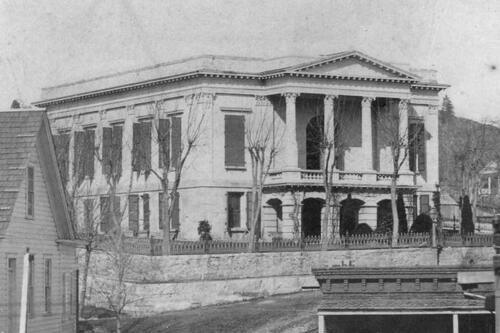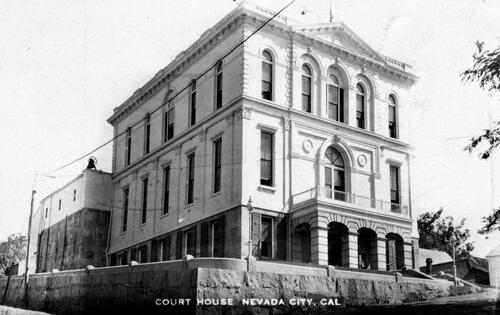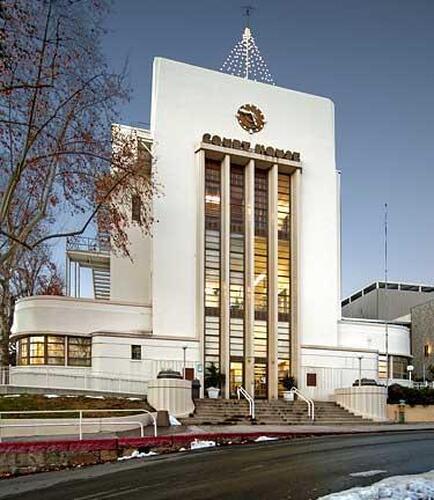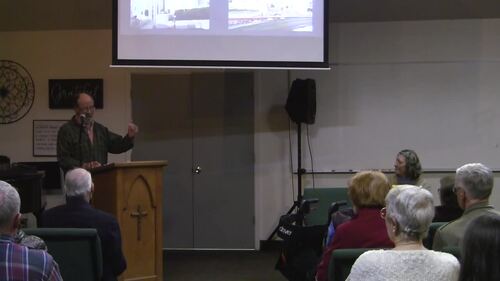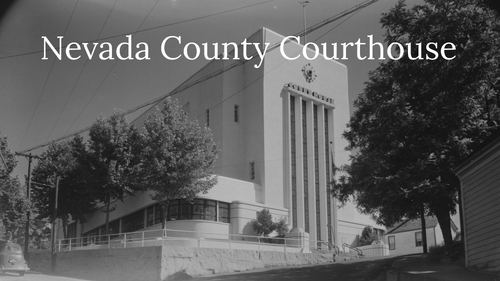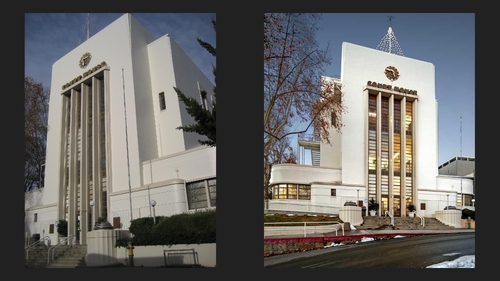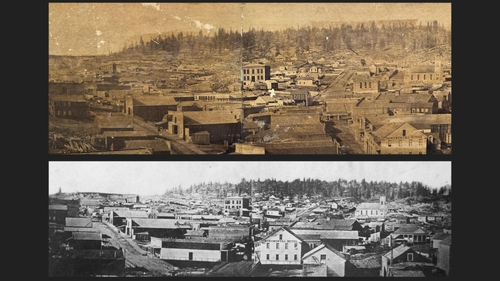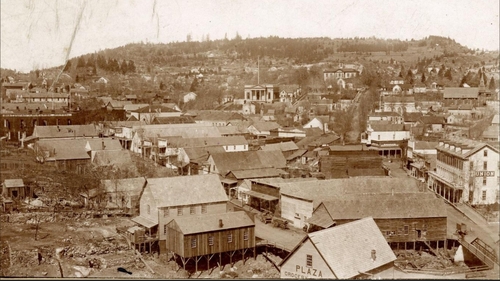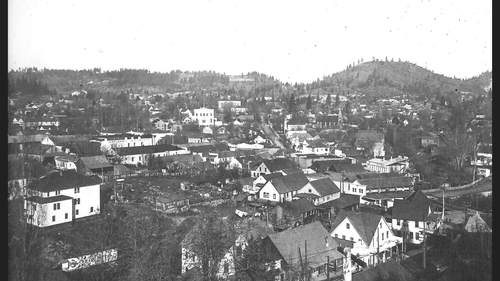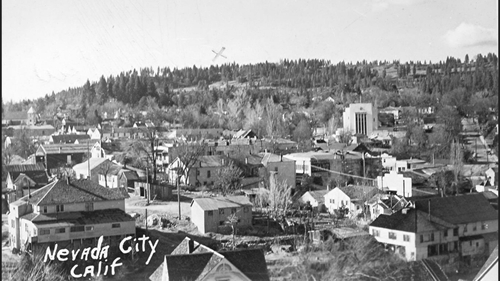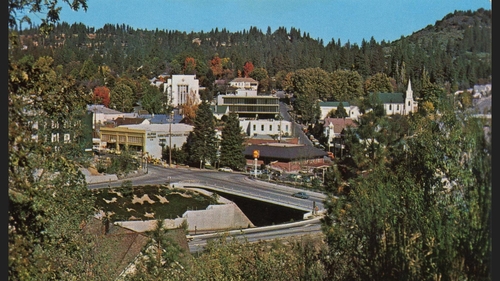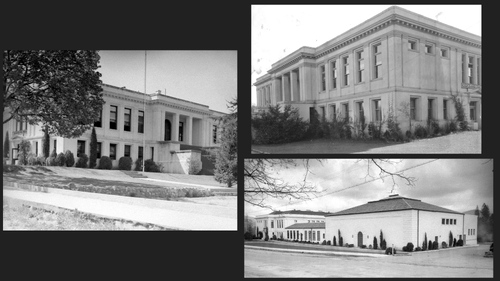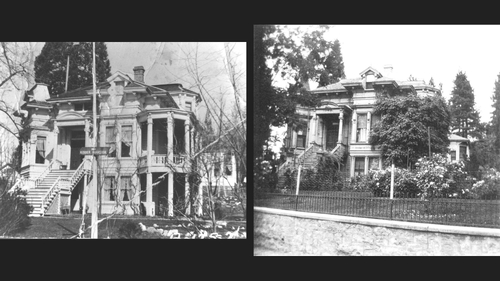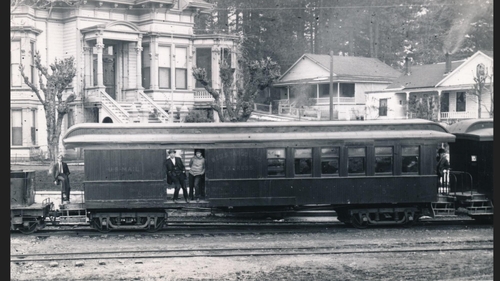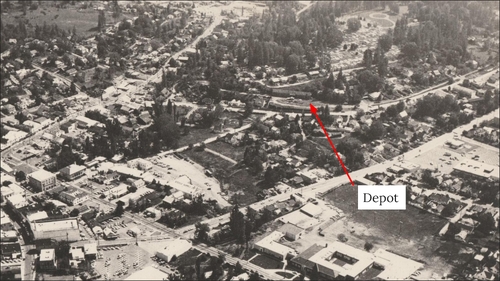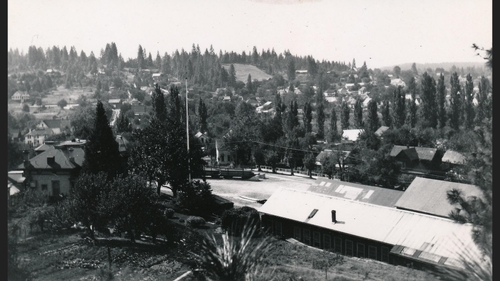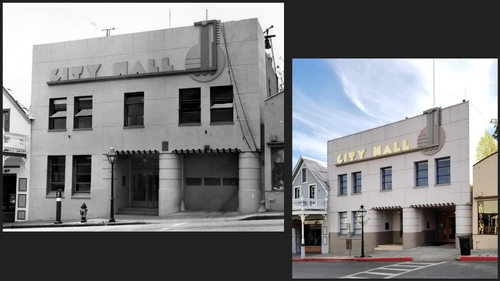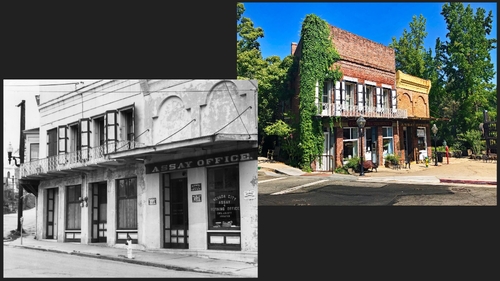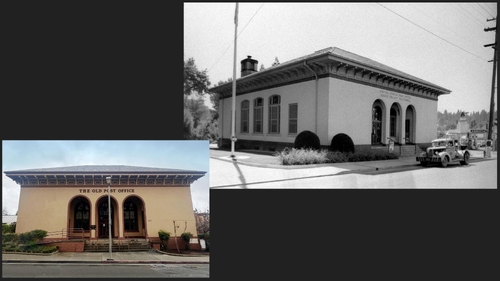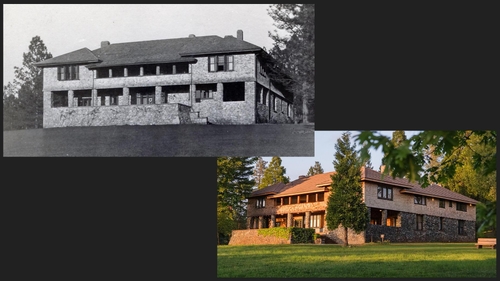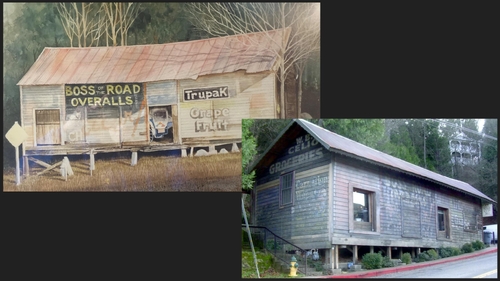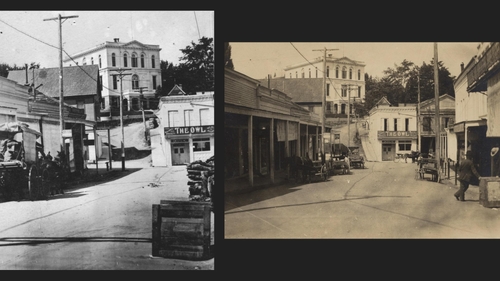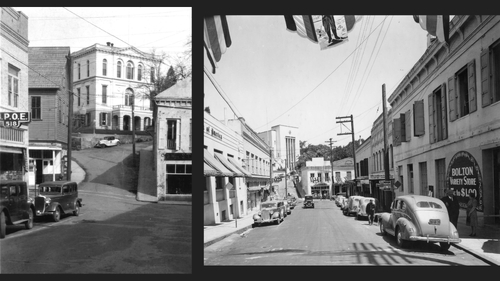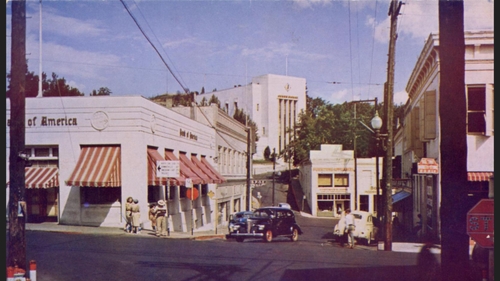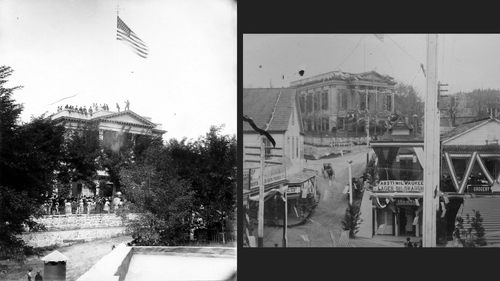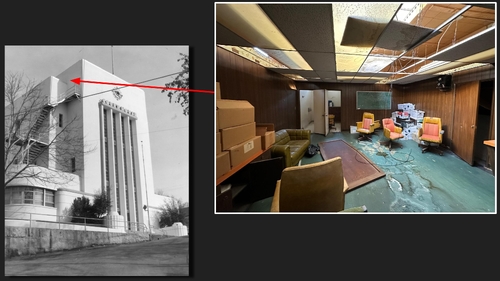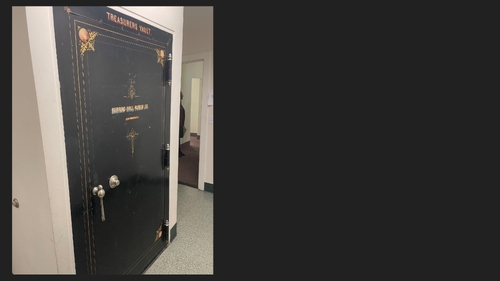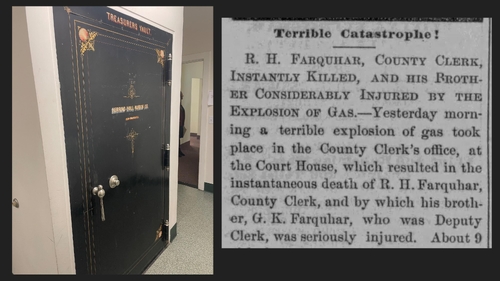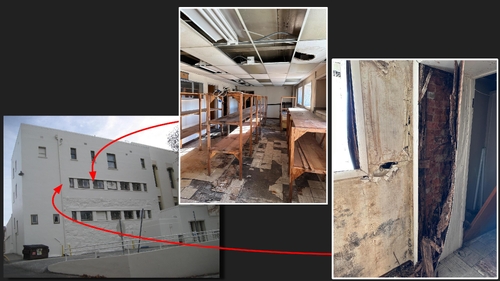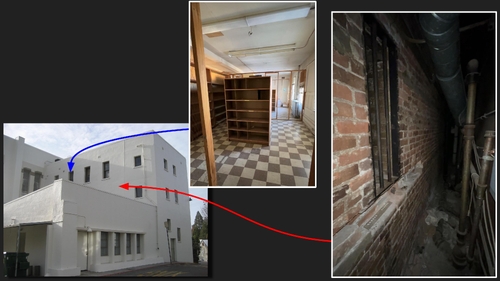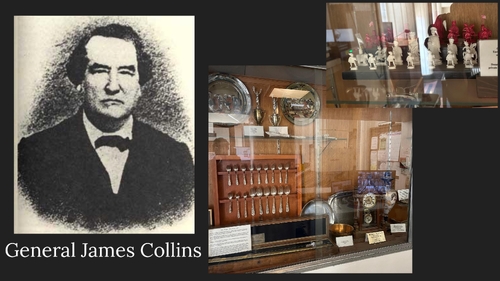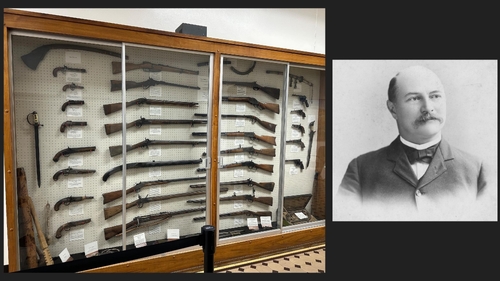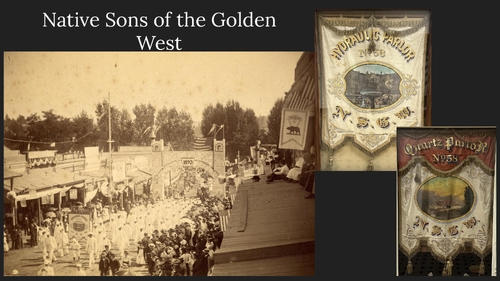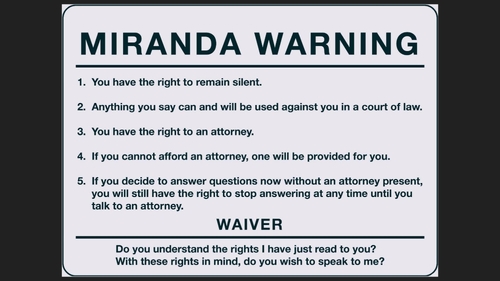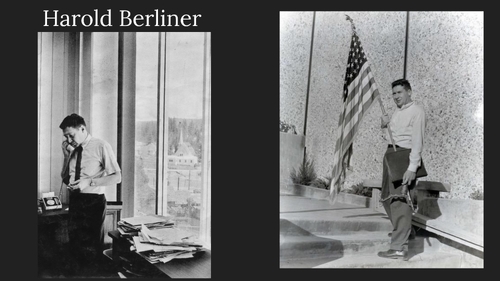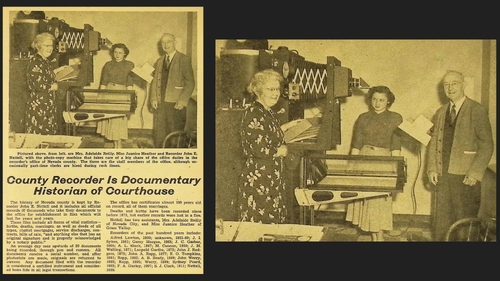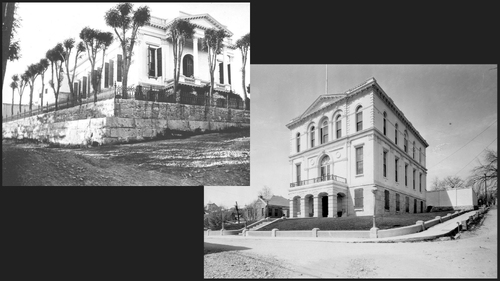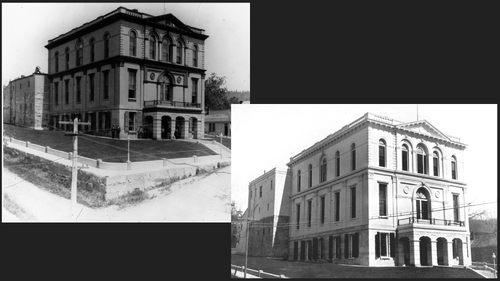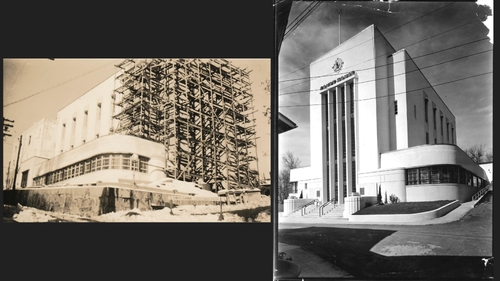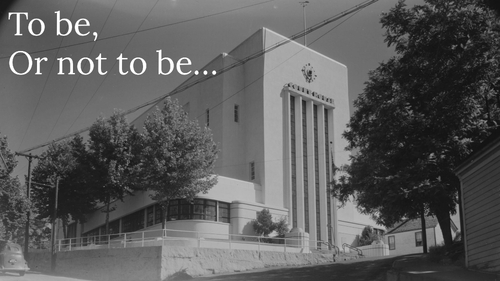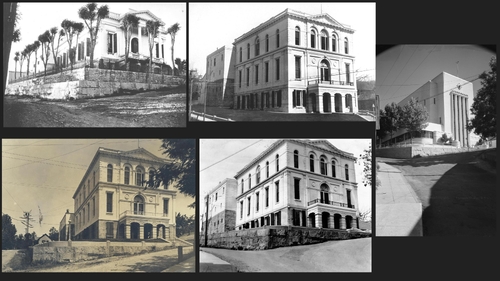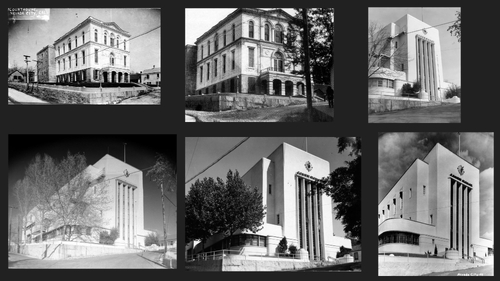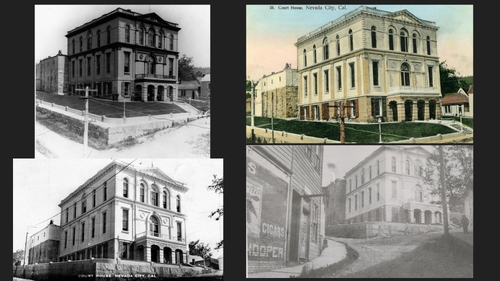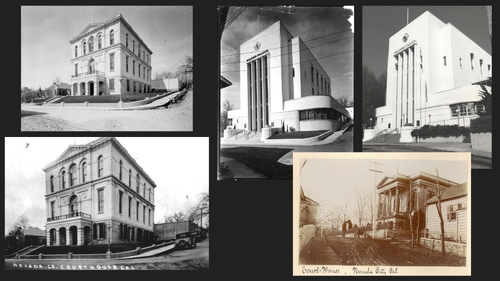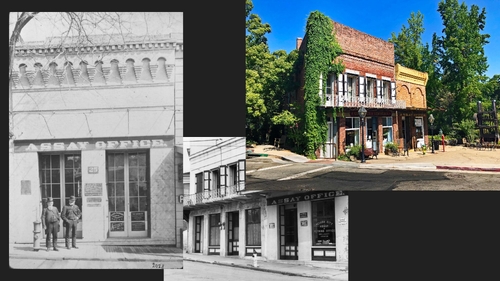Enter a name, company, place or keywords to search across this item. Then click "Search" (or hit Enter).
Collection: Videos > Speaker Nights
Video: 2025-02-20 - Nevada County Courthouse with Steve Fry, Dakota Stroh and Cathy Wilcox-Barnes (66 minutes)
You see it every time you approach Nevada City. A beautiful structure sitting atop a hill overlooking the town. The Nevada County Courthouse. You may have passed through the metal detectors to report for Jury Duty. You may have registered to vote there or recorded a deed when it still housed the County governmental offices. Have you ever wondered about that building? What the backstory is? If only walls could talk. Well, maybe the walls can't talk but at the Nevada County Historical Society's Speaker night, those walls will have representatives speaking for them. Join us Thursday evening, February 20, 2025, to learn and be entertained with details about the history of the building, fun facts about events that happened in it and famous people who walked the halls and first-hand accounts from citizens who worked or did business in it and why it is important to preserve it.
Author: Steve Fry, Dakota Stroh and Cathy Wilcox-Barnes
Published: February 20, 2025
Original Held At:
Published: February 20, 2025
Original Held At:
Full Transcript of the Video:
That should be fun. So tonight I'd like to. . . I would speculate that nearly everyone in this room has said one time stepped foot in the courthouse of that reasonably good assumption, right? Hopefully you were there as a juror and not a defendant. So we have Kathy Wilcox-Barns, Dakota Strom, and Steve Ivy speaking. Who's going to go first? I'm going to go first. Okay, you're on. Alright. I'll set this up here. So the group has gone together as Kathy, myself, Dakota, and Desmond, who's probably in the kitchen doing the important job of refreshments for us later. And we got together as a result of the county contacting the society back in November and asking for our input with respect to what is going to occur to the old courthouse after the decision had been made that the judicial council decided to actually move the new courthouse to a new location. And so the county is basically wondering, and the city is wondering, the community is wondering what's going to happen to the old courthouse. And so we got together, we prepared a report, which we shared with the membership. You probably or should have gotten it as an email. And the county and the city have gotten together and have prepared what's called a reused study. They've engaged an architectural firm. Take a look at what the possibilities are with respect to the old courthouse and the annex building, which is next door, you've all seen it. It's the one with the big exposed aggregate walls and the parking structure underneath. And then also the Washington Street parking lot. And so they basically asked us for our input. We provided our data input. And what I wanted to talk about was what set the stage for the decision by the judicial council to actually build a new courthouse in a new location. And to start with that, we had to go back to 2002, which prior to that, the counties pretty much controlled what occurred to their own individual courthouses. There was really no state involvement other than state involvement with respect to what rules were applied, procedural rules, rules of court, jury instructions. You know, things they wanted to have uniformity from county to county, but with respect to the courthouse and the facilities themselves, the county was pretty much in charge. But in 2002, that changed. And I don't know exactly why, but the Senate passed a bill in which control of the courthouses and the facilities was then shifted over to the state. And at that point, and it may have been a lot of the counties, were just simply unable to pay for what improvements needed to be done, some of the smaller counties, maybe the bigger counties, some of the smaller counties couldn't. I'm not exactly sure why they occurred, but that's just a guess. The judicial council is, just to fill you in on that, is a state agency that was formed back in 1926 by a state constitutional amendment. Initially, as I said, all they had as a responsibility was to provide uniformity with respect to rules to be applied throughout all the different counties. And the judicial council is made up of the Supreme Court Justice who in turn appoints some of the appellate court judges, some of the district court judges, some attorneys, and one representative from each house. So there's a total of 21 individuals. And so in 2002, they took control over the facilities, they generated a list of which counties needed help with respect to their facilities, which courthouses needed rehabilitation, which courthouses maybe needed to be rebuilt. And there were 34 county courthouses on that initial list. Nevada County was included, Nevada City Courthouse was included, it was kind of down the bottom of the list. And they kind of had some listed as immediate needs and they also had critical needs. Nevada County was down in the critical needs and for some reason critical was secondary to immediate. So, I mean, that's a matter of semantics, I guess. And then they received a bunch of funding and they were able to proceed, the judicial council was able to proceed with projects into the courthouses that were on the immediate, nothing Nevada County courthouse. And then in, I think it was around 2016, 2015, the budgetary funding kind of evaporated. And again, I'm not sure exactly why that occurred, but the money all of a sudden wasn't there. And so, with respect to Nevada City Courthouse and some of the other courthouses on the list, they were put on indefinitely delayed status. And that delayed status lasted for up to about 2019. So, in fact, there's about a 10-year period in which nothing really was happening with respect from the judicial council's perspective with respect to Nevada City Courthouse. That's not to say that there weren't things going on because the city and the community during that entire period were giving it a lot of consideration and there was actually a couple of studies that were done during that period. One, in fact, financed by the judicial council. And the city, in fact, on two occasions issued resolutions advocating for the courthouse to remain in its current location, building to be rehabilitated, but the courthouse to remain in its current location on Spring and Church Street. Spring and Church Street. Pine and Street. Yes. Yeah, we all know what it's up to. Anyway, so during that period of time there was a disability study that was in fact done by the judicial council and they hired an architectural firm to study and in collaboration with city officials as well as some community individuals as well. And the conclusion that they came to in that study, this was in 2015, was that Nevada City Court has been in continuous operation at the current site for 150 years. It's a major contributing factor to the economic vitality of the Nevada City Central Business District. Relocating the court from that location would create economic hardship on the Nevada City community and should it occur, it would leave behind a large vacant court building with few development options. So this was in 2015 that this study came out. Actually, they did a cost assessment on what it would cost to rehabilitate the courthouse at that time and continue operation there. And it sounds like a large number, but the estimate came in at about 66 million dollars at that point in time in 2015. A lot of this information I was able to get both from, well, the Nevada County website and you can put in courthouse, reuse study and you'll get a lot of the information there. You can go to the judicial counsel website, do the same thing, the Nevada City Courthouse, you get a lot of information there. And also from the city itself, you get a lot of information also by, you know, Googling the same sort of stuff. And then in about 2020, funding came back again pursuant to a Senate bill. And the Nevada City Courthouse went from being, you know, on the indefinitely delayed status, again on the active status. And you can get, pull up a list and this time it's been bumped up in 2020 from that low critical need area that was before up to number three on the immediate level. So all of a sudden it's, you know, it's right up there. It's, you know, one of the projects that, you know, they're going to put a lot of attention towards and pursue. And to some extent they have. And what they did was they did another study, hired another architectural firm, and this is the Judicial Council again that is drawing this. And this study, this began in 2020, 2021. And the study was basically at this point in time what they called the three option study report. And three options being number one, that the existing courthouse be rehabilitated and that it remain in its current location. Number two is that the courthouse and the, and I'm talking about the annex building as well, be raised and a new courthouse be built but on the same location where it's now. And third option is that a new courthouse be built on a new site. And as most of you probably know, they opted for option number three. And this was in 2022. They made the decision that the Judicial Council did that, you know, basically the state is going to essentially wash its hands of the existing courthouse. They have a 51% ownership interest in the building, the annex building and the Washington Street parking. And that controlling interest actually was given to them back when I was discussing 2002 when the state, you know, took over control of the courthouses. So that's how they got that 51% controlling interest. And probably what they'll do is just simply convey that controlling interest back over to the county. And then, you know, they're going to be focused on building a new courthouse. In a new location. And that new location, which we've recently heard, is going to be where the National Forest Service Office is on at the base of the North Bloomfield Road in 49. Tyrone Street. Tyrone Street. What's that? Oh, I'm sorry. Right. Okay, thank you. So that leaves us with kind of what the study that the city did in 2015 was concerned about. And that is, you know, an empty building in the middle of downtown. And so the question is, and just to give you a perspective of what that was going to cost. So that three-option estimates were, and there were a lot of factors that went into the decision, apparently. You can get the study. They have a whole spreadsheet of things that they looked at, including what their estimate costs were going to be for each of the options. And the renovation of the existing courthouse came in at about $220 million. And the new construction on the existing site came in at about $247 million. And the new construction on the new site came in at about $177 million. So somehow, and you know, you gotta remember these are architectural firms during these estimates. From 2015, for the same thing, it went from about $66 million to $220 million. Anyway, yeah, a lot of inflation going on there. So basically, that's where everything stands today. That's, you know, in a nutshell, I mean, a whole speaker tonight could be devoted to the process, you know, that I just described. And, you know, so, you know, it's been really in, you know, 20 years of limbo with respect to, you know, you know, what's going to happen to the courthouse. You know, but now there's a, you know, a pretty certain degree of certainty. Or uncertain degree of certainty that the new courthouse is going to build on a new site. And that, you know, we're going to be looking at, you know, what is to become of the old courthouse. And, you know, so, you know, what we need to do is, and what we're going to do tonight is look at the history, you know, of the old courthouse specifically. And we're going to look at, you know, what sort of impact, you know, it's had on the community, you know, over the last 150 plus years. And, as importantly, you know, what sort of impact, hopefully, you know, can we expect it, you know, for, you know, the future. And with that, I'm going to pass it on to you. Thank you, Steve. Thank you. Good evening. Can you all hear me? Yes. Okay. I'll try to use my, project my voice a little. If I start going low, raise your hand. Unless you're raising it for one of the questions I'm going to ask you. So, my part of this presentation is, I'm not going to say the boring part because there's never anything boring about, about accounting history, but I have the serious part of why historical preservation and how important it is for preserving our historic buildings. And I feel sort of like I'm preaching to the choir because you're all here tonight because you love the bad accounting history and you want to preserve it, I'm guessing. Or you're here for the free cookies afterwards. Could be a little funny. But anyway, so I'm going to start by asking a couple of questions first. My first question is, is it anybody in attendance tonight that went to Grass Valley High School or Nevada Union High School prior to 1965? Anybody? I know there's a couple because I've seen them as they were coming in. Well then, you're going to understand when I say, you know that when you're in school and you're always hoping you get a fun teacher like Chief Stevens. But you don't and you get the one that's not so fun like Dorothy Dyke. I'm Dorothy tonight. So if you've missed that, if you didn't go to Nevada Union or Grass Valley High before 1965, speak to one of the people who raised their hand and ask them about Dorothy Dyke. Anyway. I had Chief. You had Chief, okay. I did too. Anyway, so now we'll ask a couple of questions to get us started. And the first one is, Dan already asked it, how many of you have been in the courthouse? Pretty much everybody in the room. How many have you have worked in the courthouse? Great. Got some people in here that have worked in the courthouse and we're hoping to hear from some people who worked in the courthouse. But most people have been touched by Nevada County courthouse. Where are you in? How many of you went in and got your marriage license there? Todd's birth certificate was recorded there. I mean, you paid your taxes there. You registered to vote or you went there on election night to see what the results were coming in. We've been somehow involved in Nevada County Courthouse our whole life. And when you come into town, Nevada City, it's one of the first things you see as you're coming in on the freeway, over the Sacramento Street, over Crossing, you're going up Broad Street, you see the Nevada County Courthouse, that glorious building that is sitting on the hill that people have looked up and seen for over 160 years in different shapes and forms. And you're going to hear about the transitioning of the courthouse just a little bit later from Dakota. But in all these pictures, you'll see front and center in Nevada City sitting on that little knoll of Spring and Prime Street, the courthouse. So is there anybody in the room tonight who's been in Nevada County less than a year? How about less than three years? We have all season people. Less than 15? Okay, few hands go up. How about more than 30? More than 50? And how many were born and raised in Nevada County? What is the one thing, whether you've been here one year, three years, five years, 50 years, or more, I'm not going to say how many I've been here because I was giving away secrets. But anyway, what makes Nevada County home to you? What makes it feel different? How many of you came from somewhere else? And if you go back there, for instance, say you came from San Jose or you came from Long Beach and you can't even find your old neighborhood anymore and you don't know, you go down there and you don't even know where you are. That doesn't happen in Nevada County. And why is that? It's because Nevada County, we try to protect and maintain our history. And you always have this feeling of place, a way that you're connected. And when you have that feeling of place and you have that feeling of belonging and you look up and you see a familiar building that grounds you, it's your roots. You want to become more involved in the community, don't you? You feel like you're a part of the community. And that's a big part of what historic preservation is all about. When you drive into Grass Valley, maybe, and you look over and you see the veterans building, you can form home. Or you drive into Nevada City and you see the courthouse. It gives you that feeling like you're putting on your comfortable pair of sweats or your favorite tennis shoes that you always wear, you're comfortable. And it just makes you feel good. And that's what, to me, historic preservation, the importance of it is. And there's different things that come about from historic preservation. There's that feeling of, yes, this is home. And there are those tangible things and those things that remind us of the people and the events that have shaped our community. One of the things that shaped our community, sometimes we got it really right. Sometimes we kind of missed the mark a little bit. And sometimes we almost missed but pulled it out at the last minute. And so those are the things, the freeway coming through. Split both towns. I'm not saying whether that was good or bad. There was good things about it. But could it have been, could the alignment have been a little bit different so they didn't have to point that impact on the two towns? Anybody recognize this building? Raise your hand if you know what it is. Shout out the answer. Is that a city high school? That's a city high school. Where is it? It's gone. Kitter Mansion. Kitter Mansion. Gone. Now I'm going to say these are ones that maybe we could have done a little better on. Kitter Mansion. What went along with the Kitter Mansion? The railroad. The right of way to the Nevada County Railroad in night as late as I guess I'm going to say the early 1980s. The railroad right of way between Grass Valley and Nevada City was still unencumbered. Nothing built on it. Frank Ducky was the mayor of Grass Valley at the time. I happened to be mayor of Nevada City at the time. Both towns pledged not to allow any building on the right of way. The person who is this supervisor at the time bought us tooth and nail and absolutely would not try to protect it. It's encumbered now. If you go down what's now called Old Tunnel Road at the top, that was unencumbered. It now has senior apartment living on it, which was built shortly after that supervisor left office. Anyway, so, this is the Grass Valley depot, gone, and some of those probably would have gone anyway, but now we know we probably would fight a little bit harder to keep them. This is an example of where I think we did it right. Nevada City City Hall built at the same time by the same people who built the county forecast. In 1937, we restored it and it's a functioning really good building in Nevada City. Now, people can't tell the difference if they really hadn't been around for a long time. And one of the things we did not run into, even though we hear a lot, oh, we didn't run into any asbestos when we were redoing that building. Aud's Asset Office, I'm titling this one a near miss. The freeway almost took it out. The city worked with the state to change the freeway, and that job as you come down, if you're coming down 20 and you sort of do that weird job out, that was to save Aud's Asset Office and the South Ubud Canal building. And we got those, they're being used very actively today. Grass Valley's Old Post Office could have been torn down, but it was restored and functioning very well as offices. Anybody know what this one is? Our Star. How many of you know how close we came to losing that beautiful Julia Morgan structure? We came within a cat's whisker of losing that one. First, there was some intentional neglect, hoping that it would get vandalized to the point that it would either burn or be allowed to be demolished, so the subdivision could be built there, was rented out to a boys' school that did not do the kindness things to it, but the community jumped in and we have this beautiful community event place there now. You wanna recognize this one? The Celio Barn. This one came close too. It was the original warehouse building, if you wanna call it that, for the Celio Grocery later, the Plaza Grocery, that then became a number of things through the years and I left these now, and now it's your free bar and will, but this was where they saw their groceries. Then it was turned into a horse carriage business where the horses were stable for a number of years. If anyone had a reason and an excuse to tear something down, it would have been that. You couldn't walk within a block of it without smelling it. What they did, we got a person bought it and said, I'm gonna save it. There was a window inside an envelope, not a window, an envelope inside the building and we have pictures of it being braced up and the work going on, and that's, it's there today and it was used as a successful hair salon business for a number of years by Milo Hattie and now it's being used, I believe it might be being used as a private residence. So those are things that are really close, but we pulled it out. That's the last one. Okay, so I touched a couple of the things that are important about historic preservation. One of the things I want to leave, a couple of things to leave you with them from my portion, is that once it's gone, we're not getting it back. Historic preservation is never the easiest route to go, it's never the cheapest route to go and as we heard when we were meeting about the reuse of the courthouse and it doesn't, I hate this phrase, the highest and best use. Well, historic preservation is not always the highest and best use in the eyes of a developer, but it is the highest and best use in the heart and soul of that family and historic preservation doesn't happen on its own. You cannot sit back and say, I'm going to let the other guy do it while you're sitting back saying, I'm going to let the other guy do it. They may be sitting back saying, I'm going to let the other guy or gal do it. And next thing you know, you're looking to go, wow, how could we have let them tear down that beautiful courthouse? So with that, I will pose with a quote that I love and I think it sums it up for me and it's by John Steinbeck. How can we live without our lives? How will we know it is us without our paths? So it's up to us to preserve and protect that beautiful building on the hill. And now Chief Stephens part of the, just part of the presentation. Thank you. And it's going to tell us some of the fun facts and things that have happened in the courthouse. Is this working? Is this on? I don't think so. Switch. Check it out. Testing, one, two. Testing. Can you hear? Yeah. Okay. Can you hear me? Yeah. For people that don't know me, my name is Dakota Stroh. I am lucky enough to have five generations. One, the fifth generation has walked through the halls of the courthouse. It became part of the society a couple years ago and it's been wanting to do my part in preserving the history and helping educate the younger people. So I will be taking you on a little back story of the life of the courthouse and some of the things that happened in it. So looking at this picture, you'll notice one of the names right there, Blazes, a common visitor to Nevada City. He was known every time he came to town with a man named Samuel Clements. Other people know him by Mark Twain. He would always stop by there and walk around Nevada City looking for inspiration, whether it's the grounds of the courthouse or up and down Broad Street. That was where you would find him. The differences in these pictures, these are all looking up Pine Street. You'll notice that the third story was added to the courthouse. The third story was added to the courthouse in 1900. During that construction, when they were adding the third story, all official records were stored in the hall. The hall was the saloon. What better place to store all your official records than the saloon? We don't know if that was for reasons. We're just at a bar downstairs and they go upstairs and work on their official records. Or their reasoning was that it was one of the fireproof buildings as it was a brick building. No matter the architectural changes to the courthouse over the years, the one thing that was so tall for everyone walking up and down Pine Street has always been the courthouse. It's one thing, no matter how it changes, you're always seeing that courthouse. While it is a little blocked right now by trees, you don't get the best view of it. It is still there today. This one is a more modern picture. I want to probably 1950s. 40s. Okay. This one was when they raised the flag on the courthouse. On September 9th, 1889, when the flag was attached to a Liberty flagpole, the building was covered in patriotic debt. The building was built in the 19th century. The building was built in the 19th century. The building was covered in patriotic decorations in the town as well. The people covered in sidewalks, streets, balconies, or even on the roofs, as you can see, raised that in a patriotic spirit where they could work against sight. The flag measured 22 feet long and went up 50 feet in the sky so you could see from anywhere you were. Boy, that cuts so you could get up there. Yeah. So recently we were privileged to be invited for a tour of the courthouse back in December. And the CEO Layla Wahid and administrative assistant, Shannon Bowling took us on some of these areas that haven't ever been explored in the past decades. I don't want to say. One of the locations we went to was upstairs in the fourth floor was the Judge's Chambers right here. There's private chambers that went into the from the third story right there of the courtroom and went up to his office. This is a concurrent condition of it. Obviously, you can see and see better times while the furniture in there is still some authentic furniture. It's not in the best condition. This was another thing that we saw walking by us on the second floor. Layla mentioned that there's a story that's been passed around, a ghost story that someone had got trapped in the vault and died. Well, there is some truth to that. It was not trapped in there. It was the county clerk in 1867 when the explosion happened inside the vault. For some reason, they had the gas coming out into the vault. When they opened up the vault door to go in there, they lit the match and kaboom. It was R. H. Farkahar and his brother, the deputy county clerk. His brother was the one that walked in first and lit the match. He's the one that survived and he was the one inside the vault. The explosion pushed outward into the face of the county clerk and blew him back into the wall. They don't know if that was from either if his passing was from the actual explosion or the impact was so bad on the wall from the cruising. The 20 inch brick wall between the vault and the clerk's office was standing out almost 5 inches. The window frames and lights were broken and the entire outer frame of the window opening to the front of the courthouse was blown out as a long. Doors broken into fragments and many office walls were shifted including the stairs. The explosion started as I mentioned with opening the vault door. The two brothers smelt an odor but assumed it was a small gas odor as usual. George picked up a match after unlocking the inner door and lit it on the iron safe. It did not explode yet. He walked in farther in and trained in the vault as usual and nearly to the point in the inner vault where the gas jet was located the explosion happened. When did this happen? 1867. Yes, so it was three years after the building in the courthouse. So it won't take long for a person to happen. I think it was stated that people all across Nevada City felt the explosion. This is the back section where this was the old jail. This is the condition currently it was used as a storage area and just sitting there now. You'll notice that walls are falling off exposing the original brick from the 1800s. On the other side looking in, the third floor is still the DA still has an office in there for storage and is sometimes used for this extra storage on boxes that is often used to the public. Behind some of the walls you're even able to notice some of the original jail cell bars in the 1800s that are hidden behind the walls. We were hoping that Vince Sec would be here to join us as he was someone in personal experience working inside the jail. I cannot relay full stories but he did tell us a story the other week when you were talking about it and he mentioned when he was walking in there in the second floor he had a chaining of inmates walking into the courtroom. One of them as they're walking through the door into the courtroom grabs a telephone and hits one in the back of the head. He turns around and all I had to say was everybody on the ground now and I want to hit him was the first to hit the ground. Vince is not alone in his stories there is one other person in here that has shared experiences and that is Troy. Troy would you like to come up and say a few words about a personal story? I started working at the courthouse in 1972 the first time I went into the courthouse that I recall was I was a tweener I guess between 7 and 13 and what I remember most of that visit was things on the second floor there was a map of the county and a big display of butterflies and bugs and I recall that I don't know what happened to it I've asked and nobody seems to know where it went another thing I remember is after I started to work there I took my kids and several other kids from the county to the only known elevator that I knew the first time and the only time that some of them had ever ruled an elevator as far as working for the chair's office again I started in 1972 hired by Wayne Brown and worked there until I think it was 87 when we moved over to the rude building a few experiences that I recall there was one time when a guy shot his wife and her attorney in the divorce case on the second floor of the courthouse pardon it was Hunleberg who was the attorney yes did they survive? the attorney did I think both of them did well that's crazy you can create this an exciting couple of years so it's just that was probably the most exciting thing I remember in the courthouse itself yes how did someone get in with a gun? security boys that that happened back in the 1970s yeah, 1970s but how was the divorce? I think she probably got her divorce but it was interesting in that picture there this lower building here where the investigators were down right in there when I was an investigator that was from the sheriff's office that was our office and there's five or six of them sitting there but it's very interesting thank you very much I felt like it was better to hear the history from the people to experience it themselves so some of the exhibits that you might not be aware of in the courthouse when you first walk in and you look so left behind the security desk there's a bunch of things in the glass case many of the things belonging to a general James Collins now his name isn't really known about too much to a lot of people but he was a significant person in the early days he served as an Illinois militia in the 1830s serving with the likes of multiple future presidents governors and many other prominent figures including Jefferson Davis Abe Lincoln and fighting alongside President Zachary Taylor who was also a colonel at that time he later valiantly fought in the Mexican war to which he was presented a ceremonial sword that was displayed in that cabinet today let's see it right there he immigrated to California in 1849 and lived in Nevada County for his entire rest of his life in 1861 he was appointed Riveter General by Levin Stamford of the 4th division of the California militia he was the county treasurer at the time of his death in 1864 and the last thing he ever worked on was the courthouse it was said from many that knew him that if he sought higher positions such as governor, president whatever it may be he would have easily been granted them but it was his modesty and repugnance to the practice of seeking office that he never had a desire positions were instead thrust upon him to which he answered the call of compatible he never asked for preferred treatment from the public another exhibit is more home to the historical society because it is the Searle's gun collection many of these guns were owned well all the guns were owned by this man right there Fred Searle Sr some of the guns came from his dad as well Nile Searle's and these were donated to the county in 1966 the firearm collection were included many of the guns that won the west in the context of protecting and feeding the early settlers from early matchlocks as well as footlocked rifles drilling pistols and many more another exhibit that you'll see in the courthouse are the little native sons of the golden west banners these banners were were paraded throughout the cities for any of their grand parlors that took place when they were in the city of grass valley here you'll be able to see that exact banner walking through grass valley in 1892 and that's on display right there in the courthouse ok a random warning I would like to assume that can I see a show of hands everyone that has heard the Miranda warning hopefully you've heard about it or watched it TV shows you might have seen one of your favorite crime TV shows or documentaries for those that did not know the Miranda warning is a type of notification given by law enforcement authority to someone if they are a possible suspect of a crime this is to notify the person that they are not required to speak and possibly avoid self-incrimination some of you may not know Miranda warning's connection with Nevada County in 1966 a meeting of California district attorneys met to discuss how law enforcement officials should implement a new rule issued by the U. S. Supreme Court that ordered police to inform suspects in custody of their 5th amendment right against self-incrimination California Attorney General Thomas Lynch asked Deputy Attorney General Doris Meyer in Nevada County District Attorney Harold Gerleiner to craft a quick and easy statement that officers can recite during arrests this is Harold Gerleiner he was our notable district attorney which doesn't have the credit that he deserves and what he provided for the nation within two hours of being asked to draft a statement the two of them turned out was believed to be the first written version of Miranda Miranda warning stating with seven words written by Gerleiner you have the right to remain silent Gerleiner had stated later on that that he never considered to be a piece of Americana but he just thought it was a job and to get it done Gerleiner who had also earlier ran a printing press in town for small stories and books by himself printing again shortly after writing Miranda warning this time sensing a business opportunity he quickly printed out wallet-sized Miranda cards for all law enforcement agencies across the country to pull out of their wallet and show to the suspect I'd also like to make a mention that we are fortunate enough to have Harold Gerleiner's daughter here with us this evening thank you very much for joining us Praise for its simplicity and clarity the California version is the most commonly used warning today there's no worldwide audiences at Hollywood and TV shows this is a picture of him in his office next to the big glass windows now it's him going to work bringing his flag into work another person who is a special person to the historical study there's a man named John Nettle this man right here he was an uncle of Breed over to Zinski's recently and he was the county recorder in the 1940's this was their scanner he would use that in the courthouse and they bragged about they were able to scan 20 documents a day during this time the history of the county was kept by him included all official records of thousands who took the documents to the office for establishment and files which lasted for years so this is the earliest version the two-story version and you'll see the three-story next to it right here extending out used to be the wall for the jail yard when they originally had discussions about creating the third story on the courthouse it was not necessarily meant to go that way it was more of a secret and supervisors voted that they want to move the jail across the street to where the Doris Fully's library is located now and they want to make the jail cell offices well they got published in the newspaper and shortly after the county shut that down instead they built the third story this jail yard wall was taken down in 1900 and used to level out the property across the way at the Doris Fully location which two years later the Carnegie library was built there you will see the back of the jail cell which is only two stories and then the third story is added on this happened about a decade later and unfortunately the 500 pound bell that was announced for official proceedings what's going on in town and even executions will be ran so as far as executions it depended so I read that they would go outside of town and didn't want to bring it inside I also did reward execution of happening from that balcony also another one gallows were put on the front lawn and they were executed on the front lawn of the building where is the bell now don't know that was a good question I would really like to know that but that was taken down in 1912 so anybody over here has got a bell would be happy to know another thing that you can notice this original balcony when the modern structure when the modern structure added on to that in the 30's there was talks about moving this balcony because it was the original quarry granite from the 1850's and they wanted to make that the entrance of pioneer park as a memento to it unfortunately that did not happen and that ended up as a retaining wall in RJ Bennett's private park so is that where it is you can still find pieces coming up so as I mentioned 1936 is when the what we know of the courthouse today was starting to be built it was partnered with the WPA project and the SARA project which was was that the courthouse demolished or is this a remodel so as you can see in this one it was covered over so it's a remodel so there's still bits of old courthouse inside the real courthouse is still the original 1864 courthouse it's been there for 160 years was this design controversial at the time at the time not necessarily it was during the depression with the WPA project that was put on by the federal government they wanted work and it wasn't too much concern no getting rid of that because there were also a lot of complaints about lack of an elevator that did you as Pat mentioned there was a lot of complaints about a lack of an elevator having to lock up the three stories and this was added on during this and you can see the scaffolding right there early days the WPA it started out okay for the people but they were on a week to week basis so they could show up one week at work and not get notified for three weeks until the next time they're supposed to work this led to a lot of delays and they were only able to get the left wing done in a matter of 18 months when wanting to get it completed the county took over and provided county funding which saw the remaining tower elevator and right wing built within the next six months of that and that is where we are today to be or not to be that is the question and the second question yes his question was if I know about anything about the early courthouses from 1856 to when it burned down in 1863 so the original courthouse ended up was on Broad Street and that was if you're at the National Exchange you're looking across to the Alpha hardware you look to the right down the little park that's where the original courthouse was that burned down and it was moved up onto the hill into this location in 1856 it lasted about six months until that one was burnt down six months? that first one on there was burnt down was that the first one ours? no that was one of the multiple instances of the city burning down there then it was rebuilt again 1863 was when the next fire happened and then they wanted to plan to save it but the foundation was actually cracked and they had moved the foundation 10 feet forward so our original structure is the 1864 structure yes most of the early records were destroyed and this is the conclusion if anyone has any questions about the history or for either Kathy or Steve I was just mentioning one thing that so I kind of mentioned that we were lucky enough to get a guided tour of the courthouse by Layla Waleed and Shannon Bowling and at the end of that conclusion of that tour they suggested that maybe some of our members and some other members of the community might be interested in having tours as well and we said sounds like a good idea and so I had sent out a notification to our membership requesting if people were interested or not enjoying that and got a lot of response I think I got at least 40 emails in response of those 40 it was probably half were couples so that's about 60 and if you're not a member or you didn't get that email I do have a sign up sheet at the table as you walked in and go ahead and put your name down put your email address down and we're meeting next month again with Layla and Shannon to kind of discuss some of the specifics like times we don't know if they want to do it when the courthouse is closed so then how many people could group what the scope of the tour would be how far they're going to be willing to take the tour into the back rooms and so on and just kind of hammer out the details once we have those details we'll be sending out basically guest invites with days and times on that and people can actually sign up for an actual tour so if you're interested we do have that sign up list out there if you haven't already signed up or sent me your your email address and I know we're ready we've run over a little bit and I hope you've enjoyed what we've had to say we're all free up here to answer your questions John Gibbons has asked if you could just make one short comment about the courthouse yes may I I'm very sure because my wife is insisting that I make short comments so a little bit about the history of the construction our former chief justice was a gentleman named Ronald George and back for many years he was concerned that not only he wanted to establish standardized procedures throughout the court but he wanted to standardize the buildings which were at that time owned and controlled by the counties and he felt it was very hard to have an adequate and fair administration of justice but there were so many differences in the county courthouses in terms of design he felt many of them were obsolete may not have been well maintained so I can't remember if it was either a vote by the people or in the legislature but the courts the state then took over control of the courthouses only 51% this would then allow Ron George to have this standardization of courts they created an office known as the office of courthouse construction or the OCC well how do you pay for all this well I won't go into all of that let's just say it was it was creative fundraising basically if anybody here knowing about funds they were bonds that were not backed by the full faith and credit of the state we'll let it go with that okay Tom just one more quick comment Ron George was then replaced in 2010 by Arnold Schwarzenegger who appointed Tani Sakawie who then became the new chief justice and at that time Governor Brown in 2010 then cut over $600 million from the court budget over $300 million in construction and over $300 million in court administration so in July of 2010 the chief justice in order to special meeting of the judicial council how are we going to deal with these budget cuts and at that time our courthouse was listed on the critical and immediate list well what happened was a presentation was made that explained that that the court declining to spend $108 million on a new courthouse in our county well where would you put it well guess what at that time the board of education had decided to close down NCE because of declining enrollment and the office the OCC decided wouldn't that be a Jim Dandy place to build a new courthouse well you can imagine the neighborhood respond to that by the way that was also a WPA project and was designed by a fellow named William Muzer the third I think it was his grandfather who designed the grass valley library so the Muzers are very very famous family and if you look at the NCE the city elementary and Muzer's most famous design which is the San Francisco Maritime Museum you will see a family resemblance and also if you look at at NCE and the San Francisco Maritime Museum and our gorgeous courthouse once again you will see a family resemblance well the national preservation the historic society the National Society of Historic Preservation got wind of what was going on in our county and in the October issue of their magazine listed our courthouse as a threatened national treasure and then in January in the magazine they had a wonderful article on trouble in the Gold Rush town about how we were in danger of losing not only NCE but our courthouse at any rate there was a big hue and cry and finally the judicial council decided they would rather spend the 108 million dollars renovating the courthouse in San Diego instead of us what a surprise so at any rate it went on to the back burner but finally just like the horror movies the first time you kill a monster you never die you got to kill two or three times the court house we thought by 2011 we had killed the monster the judicial courthouse the judicial council had then decided to put us at the bottom of the list but somehow they found the money and so once again our courthouse is now threatened so at any time the historic society was really supportive way back then in the day of maintaining our courthouse I won't go into all the organizations the California historic foundation which is the California chapter of the National Trust for Historic Preservation came to the defense of our courthouse so there are a number of individuals organizations that just bought tooth and nail and what a surprise we lost but at any rate I hope you can find a good place for it but if anybody is interested a little more of history and the legal issue of what transpired way back the courthouse was supposed to be torn down in 2015 and at least be belated for a decade thank you for your extra advice
That should be fun. So tonight I'd like to. . . I would speculate that nearly everyone in this room has said one time stepped foot in the courthouse of that reasonably good assumption, right? Hopefully you were there as a juror and not a defendant. So we have Kathy Wilcox-Barns, Dakota Strom, and Steve Ivy speaking. Who's going to go first? I'm going to go first. Okay, you're on. Alright. I'll set this up here. So the group has gone together as Kathy, myself, Dakota, and Desmond, who's probably in the kitchen doing the important job of refreshments for us later. And we got together as a result of the county contacting the society back in November and asking for our input with respect to what is going to occur to the old courthouse after the decision had been made that the judicial council decided to actually move the new courthouse to a new location. And so the county is basically wondering, and the city is wondering, the community is wondering what's going to happen to the old courthouse. And so we got together, we prepared a report, which we shared with the membership. You probably or should have gotten it as an email. And the county and the city have gotten together and have prepared what's called a reused study. They've engaged an architectural firm. Take a look at what the possibilities are with respect to the old courthouse and the annex building, which is next door, you've all seen it. It's the one with the big exposed aggregate walls and the parking structure underneath. And then also the Washington Street parking lot. And so they basically asked us for our input. We provided our data input. And what I wanted to talk about was what set the stage for the decision by the judicial council to actually build a new courthouse in a new location. And to start with that, we had to go back to 2002, which prior to that, the counties pretty much controlled what occurred to their own individual courthouses. There was really no state involvement other than state involvement with respect to what rules were applied, procedural rules, rules of court, jury instructions. You know, things they wanted to have uniformity from county to county, but with respect to the courthouse and the facilities themselves, the county was pretty much in charge. But in 2002, that changed. And I don't know exactly why, but the Senate passed a bill in which control of the courthouses and the facilities was then shifted over to the state. And at that point, and it may have been a lot of the counties, were just simply unable to pay for what improvements needed to be done, some of the smaller counties, maybe the bigger counties, some of the smaller counties couldn't. I'm not exactly sure why they occurred, but that's just a guess. The judicial council is, just to fill you in on that, is a state agency that was formed back in 1926 by a state constitutional amendment. Initially, as I said, all they had as a responsibility was to provide uniformity with respect to rules to be applied throughout all the different counties. And the judicial council is made up of the Supreme Court Justice who in turn appoints some of the appellate court judges, some of the district court judges, some attorneys, and one representative from each house. So there's a total of 21 individuals. And so in 2002, they took control over the facilities, they generated a list of which counties needed help with respect to their facilities, which courthouses needed rehabilitation, which courthouses maybe needed to be rebuilt. And there were 34 county courthouses on that initial list. Nevada County was included, Nevada City Courthouse was included, it was kind of down the bottom of the list. And they kind of had some listed as immediate needs and they also had critical needs. Nevada County was down in the critical needs and for some reason critical was secondary to immediate. So, I mean, that's a matter of semantics, I guess. And then they received a bunch of funding and they were able to proceed, the judicial council was able to proceed with projects into the courthouses that were on the immediate, nothing Nevada County courthouse. And then in, I think it was around 2016, 2015, the budgetary funding kind of evaporated. And again, I'm not sure exactly why that occurred, but the money all of a sudden wasn't there. And so, with respect to Nevada City Courthouse and some of the other courthouses on the list, they were put on indefinitely delayed status. And that delayed status lasted for up to about 2019. So, in fact, there's about a 10-year period in which nothing really was happening with respect from the judicial council's perspective with respect to Nevada City Courthouse. That's not to say that there weren't things going on because the city and the community during that entire period were giving it a lot of consideration and there was actually a couple of studies that were done during that period. One, in fact, financed by the judicial council. And the city, in fact, on two occasions issued resolutions advocating for the courthouse to remain in its current location, building to be rehabilitated, but the courthouse to remain in its current location on Spring and Church Street. Spring and Church Street. Pine and Street. Yes. Yeah, we all know what it's up to. Anyway, so during that period of time there was a disability study that was in fact done by the judicial council and they hired an architectural firm to study and in collaboration with city officials as well as some community individuals as well. And the conclusion that they came to in that study, this was in 2015, was that Nevada City Court has been in continuous operation at the current site for 150 years. It's a major contributing factor to the economic vitality of the Nevada City Central Business District. Relocating the court from that location would create economic hardship on the Nevada City community and should it occur, it would leave behind a large vacant court building with few development options. So this was in 2015 that this study came out. Actually, they did a cost assessment on what it would cost to rehabilitate the courthouse at that time and continue operation there. And it sounds like a large number, but the estimate came in at about 66 million dollars at that point in time in 2015. A lot of this information I was able to get both from, well, the Nevada County website and you can put in courthouse, reuse study and you'll get a lot of the information there. You can go to the judicial counsel website, do the same thing, the Nevada City Courthouse, you get a lot of information there. And also from the city itself, you get a lot of information also by, you know, Googling the same sort of stuff. And then in about 2020, funding came back again pursuant to a Senate bill. And the Nevada City Courthouse went from being, you know, on the indefinitely delayed status, again on the active status. And you can get, pull up a list and this time it's been bumped up in 2020 from that low critical need area that was before up to number three on the immediate level. So all of a sudden it's, you know, it's right up there. It's, you know, one of the projects that, you know, they're going to put a lot of attention towards and pursue. And to some extent they have. And what they did was they did another study, hired another architectural firm, and this is the Judicial Council again that is drawing this. And this study, this began in 2020, 2021. And the study was basically at this point in time what they called the three option study report. And three options being number one, that the existing courthouse be rehabilitated and that it remain in its current location. Number two is that the courthouse and the, and I'm talking about the annex building as well, be raised and a new courthouse be built but on the same location where it's now. And third option is that a new courthouse be built on a new site. And as most of you probably know, they opted for option number three. And this was in 2022. They made the decision that the Judicial Council did that, you know, basically the state is going to essentially wash its hands of the existing courthouse. They have a 51% ownership interest in the building, the annex building and the Washington Street parking. And that controlling interest actually was given to them back when I was discussing 2002 when the state, you know, took over control of the courthouses. So that's how they got that 51% controlling interest. And probably what they'll do is just simply convey that controlling interest back over to the county. And then, you know, they're going to be focused on building a new courthouse. In a new location. And that new location, which we've recently heard, is going to be where the National Forest Service Office is on at the base of the North Bloomfield Road in 49. Tyrone Street. Tyrone Street. What's that? Oh, I'm sorry. Right. Okay, thank you. So that leaves us with kind of what the study that the city did in 2015 was concerned about. And that is, you know, an empty building in the middle of downtown. And so the question is, and just to give you a perspective of what that was going to cost. So that three-option estimates were, and there were a lot of factors that went into the decision, apparently. You can get the study. They have a whole spreadsheet of things that they looked at, including what their estimate costs were going to be for each of the options. And the renovation of the existing courthouse came in at about $220 million. And the new construction on the existing site came in at about $247 million. And the new construction on the new site came in at about $177 million. So somehow, and you know, you gotta remember these are architectural firms during these estimates. From 2015, for the same thing, it went from about $66 million to $220 million. Anyway, yeah, a lot of inflation going on there. So basically, that's where everything stands today. That's, you know, in a nutshell, I mean, a whole speaker tonight could be devoted to the process, you know, that I just described. And, you know, so, you know, it's been really in, you know, 20 years of limbo with respect to, you know, you know, what's going to happen to the courthouse. You know, but now there's a, you know, a pretty certain degree of certainty. Or uncertain degree of certainty that the new courthouse is going to build on a new site. And that, you know, we're going to be looking at, you know, what is to become of the old courthouse. And, you know, so, you know, what we need to do is, and what we're going to do tonight is look at the history, you know, of the old courthouse specifically. And we're going to look at, you know, what sort of impact, you know, it's had on the community, you know, over the last 150 plus years. And, as importantly, you know, what sort of impact, hopefully, you know, can we expect it, you know, for, you know, the future. And with that, I'm going to pass it on to you. Thank you, Steve. Thank you. Good evening. Can you all hear me? Yes. Okay. I'll try to use my, project my voice a little. If I start going low, raise your hand. Unless you're raising it for one of the questions I'm going to ask you. So, my part of this presentation is, I'm not going to say the boring part because there's never anything boring about, about accounting history, but I have the serious part of why historical preservation and how important it is for preserving our historic buildings. And I feel sort of like I'm preaching to the choir because you're all here tonight because you love the bad accounting history and you want to preserve it, I'm guessing. Or you're here for the free cookies afterwards. Could be a little funny. But anyway, so I'm going to start by asking a couple of questions first. My first question is, is it anybody in attendance tonight that went to Grass Valley High School or Nevada Union High School prior to 1965? Anybody? I know there's a couple because I've seen them as they were coming in. Well then, you're going to understand when I say, you know that when you're in school and you're always hoping you get a fun teacher like Chief Stevens. But you don't and you get the one that's not so fun like Dorothy Dyke. I'm Dorothy tonight. So if you've missed that, if you didn't go to Nevada Union or Grass Valley High before 1965, speak to one of the people who raised their hand and ask them about Dorothy Dyke. Anyway. I had Chief. You had Chief, okay. I did too. Anyway, so now we'll ask a couple of questions to get us started. And the first one is, Dan already asked it, how many of you have been in the courthouse? Pretty much everybody in the room. How many have you have worked in the courthouse? Great. Got some people in here that have worked in the courthouse and we're hoping to hear from some people who worked in the courthouse. But most people have been touched by Nevada County courthouse. Where are you in? How many of you went in and got your marriage license there? Todd's birth certificate was recorded there. I mean, you paid your taxes there. You registered to vote or you went there on election night to see what the results were coming in. We've been somehow involved in Nevada County Courthouse our whole life. And when you come into town, Nevada City, it's one of the first things you see as you're coming in on the freeway, over the Sacramento Street, over Crossing, you're going up Broad Street, you see the Nevada County Courthouse, that glorious building that is sitting on the hill that people have looked up and seen for over 160 years in different shapes and forms. And you're going to hear about the transitioning of the courthouse just a little bit later from Dakota. But in all these pictures, you'll see front and center in Nevada City sitting on that little knoll of Spring and Prime Street, the courthouse. So is there anybody in the room tonight who's been in Nevada County less than a year? How about less than three years? We have all season people. Less than 15? Okay, few hands go up. How about more than 30? More than 50? And how many were born and raised in Nevada County? What is the one thing, whether you've been here one year, three years, five years, 50 years, or more, I'm not going to say how many I've been here because I was giving away secrets. But anyway, what makes Nevada County home to you? What makes it feel different? How many of you came from somewhere else? And if you go back there, for instance, say you came from San Jose or you came from Long Beach and you can't even find your old neighborhood anymore and you don't know, you go down there and you don't even know where you are. That doesn't happen in Nevada County. And why is that? It's because Nevada County, we try to protect and maintain our history. And you always have this feeling of place, a way that you're connected. And when you have that feeling of place and you have that feeling of belonging and you look up and you see a familiar building that grounds you, it's your roots. You want to become more involved in the community, don't you? You feel like you're a part of the community. And that's a big part of what historic preservation is all about. When you drive into Grass Valley, maybe, and you look over and you see the veterans building, you can form home. Or you drive into Nevada City and you see the courthouse. It gives you that feeling like you're putting on your comfortable pair of sweats or your favorite tennis shoes that you always wear, you're comfortable. And it just makes you feel good. And that's what, to me, historic preservation, the importance of it is. And there's different things that come about from historic preservation. There's that feeling of, yes, this is home. And there are those tangible things and those things that remind us of the people and the events that have shaped our community. One of the things that shaped our community, sometimes we got it really right. Sometimes we kind of missed the mark a little bit. And sometimes we almost missed but pulled it out at the last minute. And so those are the things, the freeway coming through. Split both towns. I'm not saying whether that was good or bad. There was good things about it. But could it have been, could the alignment have been a little bit different so they didn't have to point that impact on the two towns? Anybody recognize this building? Raise your hand if you know what it is. Shout out the answer. Is that a city high school? That's a city high school. Where is it? It's gone. Kitter Mansion. Kitter Mansion. Gone. Now I'm going to say these are ones that maybe we could have done a little better on. Kitter Mansion. What went along with the Kitter Mansion? The railroad. The right of way to the Nevada County Railroad in night as late as I guess I'm going to say the early 1980s. The railroad right of way between Grass Valley and Nevada City was still unencumbered. Nothing built on it. Frank Ducky was the mayor of Grass Valley at the time. I happened to be mayor of Nevada City at the time. Both towns pledged not to allow any building on the right of way. The person who is this supervisor at the time bought us tooth and nail and absolutely would not try to protect it. It's encumbered now. If you go down what's now called Old Tunnel Road at the top, that was unencumbered. It now has senior apartment living on it, which was built shortly after that supervisor left office. Anyway, so, this is the Grass Valley depot, gone, and some of those probably would have gone anyway, but now we know we probably would fight a little bit harder to keep them. This is an example of where I think we did it right. Nevada City City Hall built at the same time by the same people who built the county forecast. In 1937, we restored it and it's a functioning really good building in Nevada City. Now, people can't tell the difference if they really hadn't been around for a long time. And one of the things we did not run into, even though we hear a lot, oh, we didn't run into any asbestos when we were redoing that building. Aud's Asset Office, I'm titling this one a near miss. The freeway almost took it out. The city worked with the state to change the freeway, and that job as you come down, if you're coming down 20 and you sort of do that weird job out, that was to save Aud's Asset Office and the South Ubud Canal building. And we got those, they're being used very actively today. Grass Valley's Old Post Office could have been torn down, but it was restored and functioning very well as offices. Anybody know what this one is? Our Star. How many of you know how close we came to losing that beautiful Julia Morgan structure? We came within a cat's whisker of losing that one. First, there was some intentional neglect, hoping that it would get vandalized to the point that it would either burn or be allowed to be demolished, so the subdivision could be built there, was rented out to a boys' school that did not do the kindness things to it, but the community jumped in and we have this beautiful community event place there now. You wanna recognize this one? The Celio Barn. This one came close too. It was the original warehouse building, if you wanna call it that, for the Celio Grocery later, the Plaza Grocery, that then became a number of things through the years and I left these now, and now it's your free bar and will, but this was where they saw their groceries. Then it was turned into a horse carriage business where the horses were stable for a number of years. If anyone had a reason and an excuse to tear something down, it would have been that. You couldn't walk within a block of it without smelling it. What they did, we got a person bought it and said, I'm gonna save it. There was a window inside an envelope, not a window, an envelope inside the building and we have pictures of it being braced up and the work going on, and that's, it's there today and it was used as a successful hair salon business for a number of years by Milo Hattie and now it's being used, I believe it might be being used as a private residence. So those are things that are really close, but we pulled it out. That's the last one. Okay, so I touched a couple of the things that are important about historic preservation. One of the things I want to leave, a couple of things to leave you with them from my portion, is that once it's gone, we're not getting it back. Historic preservation is never the easiest route to go, it's never the cheapest route to go and as we heard when we were meeting about the reuse of the courthouse and it doesn't, I hate this phrase, the highest and best use. Well, historic preservation is not always the highest and best use in the eyes of a developer, but it is the highest and best use in the heart and soul of that family and historic preservation doesn't happen on its own. You cannot sit back and say, I'm going to let the other guy do it while you're sitting back saying, I'm going to let the other guy do it. They may be sitting back saying, I'm going to let the other guy or gal do it. And next thing you know, you're looking to go, wow, how could we have let them tear down that beautiful courthouse? So with that, I will pose with a quote that I love and I think it sums it up for me and it's by John Steinbeck. How can we live without our lives? How will we know it is us without our paths? So it's up to us to preserve and protect that beautiful building on the hill. And now Chief Stephens part of the, just part of the presentation. Thank you. And it's going to tell us some of the fun facts and things that have happened in the courthouse. Is this working? Is this on? I don't think so. Switch. Check it out. Testing, one, two. Testing. Can you hear? Yeah. Okay. Can you hear me? Yeah. For people that don't know me, my name is Dakota Stroh. I am lucky enough to have five generations. One, the fifth generation has walked through the halls of the courthouse. It became part of the society a couple years ago and it's been wanting to do my part in preserving the history and helping educate the younger people. So I will be taking you on a little back story of the life of the courthouse and some of the things that happened in it. So looking at this picture, you'll notice one of the names right there, Blazes, a common visitor to Nevada City. He was known every time he came to town with a man named Samuel Clements. Other people know him by Mark Twain. He would always stop by there and walk around Nevada City looking for inspiration, whether it's the grounds of the courthouse or up and down Broad Street. That was where you would find him. The differences in these pictures, these are all looking up Pine Street. You'll notice that the third story was added to the courthouse. The third story was added to the courthouse in 1900. During that construction, when they were adding the third story, all official records were stored in the hall. The hall was the saloon. What better place to store all your official records than the saloon? We don't know if that was for reasons. We're just at a bar downstairs and they go upstairs and work on their official records. Or their reasoning was that it was one of the fireproof buildings as it was a brick building. No matter the architectural changes to the courthouse over the years, the one thing that was so tall for everyone walking up and down Pine Street has always been the courthouse. It's one thing, no matter how it changes, you're always seeing that courthouse. While it is a little blocked right now by trees, you don't get the best view of it. It is still there today. This one is a more modern picture. I want to probably 1950s. 40s. Okay. This one was when they raised the flag on the courthouse. On September 9th, 1889, when the flag was attached to a Liberty flagpole, the building was covered in patriotic debt. The building was built in the 19th century. The building was built in the 19th century. The building was covered in patriotic decorations in the town as well. The people covered in sidewalks, streets, balconies, or even on the roofs, as you can see, raised that in a patriotic spirit where they could work against sight. The flag measured 22 feet long and went up 50 feet in the sky so you could see from anywhere you were. Boy, that cuts so you could get up there. Yeah. So recently we were privileged to be invited for a tour of the courthouse back in December. And the CEO Layla Wahid and administrative assistant, Shannon Bowling took us on some of these areas that haven't ever been explored in the past decades. I don't want to say. One of the locations we went to was upstairs in the fourth floor was the Judge's Chambers right here. There's private chambers that went into the from the third story right there of the courtroom and went up to his office. This is a concurrent condition of it. Obviously, you can see and see better times while the furniture in there is still some authentic furniture. It's not in the best condition. This was another thing that we saw walking by us on the second floor. Layla mentioned that there's a story that's been passed around, a ghost story that someone had got trapped in the vault and died. Well, there is some truth to that. It was not trapped in there. It was the county clerk in 1867 when the explosion happened inside the vault. For some reason, they had the gas coming out into the vault. When they opened up the vault door to go in there, they lit the match and kaboom. It was R. H. Farkahar and his brother, the deputy county clerk. His brother was the one that walked in first and lit the match. He's the one that survived and he was the one inside the vault. The explosion pushed outward into the face of the county clerk and blew him back into the wall. They don't know if that was from either if his passing was from the actual explosion or the impact was so bad on the wall from the cruising. The 20 inch brick wall between the vault and the clerk's office was standing out almost 5 inches. The window frames and lights were broken and the entire outer frame of the window opening to the front of the courthouse was blown out as a long. Doors broken into fragments and many office walls were shifted including the stairs. The explosion started as I mentioned with opening the vault door. The two brothers smelt an odor but assumed it was a small gas odor as usual. George picked up a match after unlocking the inner door and lit it on the iron safe. It did not explode yet. He walked in farther in and trained in the vault as usual and nearly to the point in the inner vault where the gas jet was located the explosion happened. When did this happen? 1867. Yes, so it was three years after the building in the courthouse. So it won't take long for a person to happen. I think it was stated that people all across Nevada City felt the explosion. This is the back section where this was the old jail. This is the condition currently it was used as a storage area and just sitting there now. You'll notice that walls are falling off exposing the original brick from the 1800s. On the other side looking in, the third floor is still the DA still has an office in there for storage and is sometimes used for this extra storage on boxes that is often used to the public. Behind some of the walls you're even able to notice some of the original jail cell bars in the 1800s that are hidden behind the walls. We were hoping that Vince Sec would be here to join us as he was someone in personal experience working inside the jail. I cannot relay full stories but he did tell us a story the other week when you were talking about it and he mentioned when he was walking in there in the second floor he had a chaining of inmates walking into the courtroom. One of them as they're walking through the door into the courtroom grabs a telephone and hits one in the back of the head. He turns around and all I had to say was everybody on the ground now and I want to hit him was the first to hit the ground. Vince is not alone in his stories there is one other person in here that has shared experiences and that is Troy. Troy would you like to come up and say a few words about a personal story? I started working at the courthouse in 1972 the first time I went into the courthouse that I recall was I was a tweener I guess between 7 and 13 and what I remember most of that visit was things on the second floor there was a map of the county and a big display of butterflies and bugs and I recall that I don't know what happened to it I've asked and nobody seems to know where it went another thing I remember is after I started to work there I took my kids and several other kids from the county to the only known elevator that I knew the first time and the only time that some of them had ever ruled an elevator as far as working for the chair's office again I started in 1972 hired by Wayne Brown and worked there until I think it was 87 when we moved over to the rude building a few experiences that I recall there was one time when a guy shot his wife and her attorney in the divorce case on the second floor of the courthouse pardon it was Hunleberg who was the attorney yes did they survive? the attorney did I think both of them did well that's crazy you can create this an exciting couple of years so it's just that was probably the most exciting thing I remember in the courthouse itself yes how did someone get in with a gun? security boys that that happened back in the 1970s yeah, 1970s but how was the divorce? I think she probably got her divorce but it was interesting in that picture there this lower building here where the investigators were down right in there when I was an investigator that was from the sheriff's office that was our office and there's five or six of them sitting there but it's very interesting thank you very much I felt like it was better to hear the history from the people to experience it themselves so some of the exhibits that you might not be aware of in the courthouse when you first walk in and you look so left behind the security desk there's a bunch of things in the glass case many of the things belonging to a general James Collins now his name isn't really known about too much to a lot of people but he was a significant person in the early days he served as an Illinois militia in the 1830s serving with the likes of multiple future presidents governors and many other prominent figures including Jefferson Davis Abe Lincoln and fighting alongside President Zachary Taylor who was also a colonel at that time he later valiantly fought in the Mexican war to which he was presented a ceremonial sword that was displayed in that cabinet today let's see it right there he immigrated to California in 1849 and lived in Nevada County for his entire rest of his life in 1861 he was appointed Riveter General by Levin Stamford of the 4th division of the California militia he was the county treasurer at the time of his death in 1864 and the last thing he ever worked on was the courthouse it was said from many that knew him that if he sought higher positions such as governor, president whatever it may be he would have easily been granted them but it was his modesty and repugnance to the practice of seeking office that he never had a desire positions were instead thrust upon him to which he answered the call of compatible he never asked for preferred treatment from the public another exhibit is more home to the historical society because it is the Searle's gun collection many of these guns were owned well all the guns were owned by this man right there Fred Searle Sr some of the guns came from his dad as well Nile Searle's and these were donated to the county in 1966 the firearm collection were included many of the guns that won the west in the context of protecting and feeding the early settlers from early matchlocks as well as footlocked rifles drilling pistols and many more another exhibit that you'll see in the courthouse are the little native sons of the golden west banners these banners were were paraded throughout the cities for any of their grand parlors that took place when they were in the city of grass valley here you'll be able to see that exact banner walking through grass valley in 1892 and that's on display right there in the courthouse ok a random warning I would like to assume that can I see a show of hands everyone that has heard the Miranda warning hopefully you've heard about it or watched it TV shows you might have seen one of your favorite crime TV shows or documentaries for those that did not know the Miranda warning is a type of notification given by law enforcement authority to someone if they are a possible suspect of a crime this is to notify the person that they are not required to speak and possibly avoid self-incrimination some of you may not know Miranda warning's connection with Nevada County in 1966 a meeting of California district attorneys met to discuss how law enforcement officials should implement a new rule issued by the U. S. Supreme Court that ordered police to inform suspects in custody of their 5th amendment right against self-incrimination California Attorney General Thomas Lynch asked Deputy Attorney General Doris Meyer in Nevada County District Attorney Harold Gerleiner to craft a quick and easy statement that officers can recite during arrests this is Harold Gerleiner he was our notable district attorney which doesn't have the credit that he deserves and what he provided for the nation within two hours of being asked to draft a statement the two of them turned out was believed to be the first written version of Miranda Miranda warning stating with seven words written by Gerleiner you have the right to remain silent Gerleiner had stated later on that that he never considered to be a piece of Americana but he just thought it was a job and to get it done Gerleiner who had also earlier ran a printing press in town for small stories and books by himself printing again shortly after writing Miranda warning this time sensing a business opportunity he quickly printed out wallet-sized Miranda cards for all law enforcement agencies across the country to pull out of their wallet and show to the suspect I'd also like to make a mention that we are fortunate enough to have Harold Gerleiner's daughter here with us this evening thank you very much for joining us Praise for its simplicity and clarity the California version is the most commonly used warning today there's no worldwide audiences at Hollywood and TV shows this is a picture of him in his office next to the big glass windows now it's him going to work bringing his flag into work another person who is a special person to the historical study there's a man named John Nettle this man right here he was an uncle of Breed over to Zinski's recently and he was the county recorder in the 1940's this was their scanner he would use that in the courthouse and they bragged about they were able to scan 20 documents a day during this time the history of the county was kept by him included all official records of thousands who took the documents to the office for establishment and files which lasted for years so this is the earliest version the two-story version and you'll see the three-story next to it right here extending out used to be the wall for the jail yard when they originally had discussions about creating the third story on the courthouse it was not necessarily meant to go that way it was more of a secret and supervisors voted that they want to move the jail across the street to where the Doris Fully's library is located now and they want to make the jail cell offices well they got published in the newspaper and shortly after the county shut that down instead they built the third story this jail yard wall was taken down in 1900 and used to level out the property across the way at the Doris Fully location which two years later the Carnegie library was built there you will see the back of the jail cell which is only two stories and then the third story is added on this happened about a decade later and unfortunately the 500 pound bell that was announced for official proceedings what's going on in town and even executions will be ran so as far as executions it depended so I read that they would go outside of town and didn't want to bring it inside I also did reward execution of happening from that balcony also another one gallows were put on the front lawn and they were executed on the front lawn of the building where is the bell now don't know that was a good question I would really like to know that but that was taken down in 1912 so anybody over here has got a bell would be happy to know another thing that you can notice this original balcony when the modern structure when the modern structure added on to that in the 30's there was talks about moving this balcony because it was the original quarry granite from the 1850's and they wanted to make that the entrance of pioneer park as a memento to it unfortunately that did not happen and that ended up as a retaining wall in RJ Bennett's private park so is that where it is you can still find pieces coming up so as I mentioned 1936 is when the what we know of the courthouse today was starting to be built it was partnered with the WPA project and the SARA project which was was that the courthouse demolished or is this a remodel so as you can see in this one it was covered over so it's a remodel so there's still bits of old courthouse inside the real courthouse is still the original 1864 courthouse it's been there for 160 years was this design controversial at the time at the time not necessarily it was during the depression with the WPA project that was put on by the federal government they wanted work and it wasn't too much concern no getting rid of that because there were also a lot of complaints about lack of an elevator that did you as Pat mentioned there was a lot of complaints about a lack of an elevator having to lock up the three stories and this was added on during this and you can see the scaffolding right there early days the WPA it started out okay for the people but they were on a week to week basis so they could show up one week at work and not get notified for three weeks until the next time they're supposed to work this led to a lot of delays and they were only able to get the left wing done in a matter of 18 months when wanting to get it completed the county took over and provided county funding which saw the remaining tower elevator and right wing built within the next six months of that and that is where we are today to be or not to be that is the question and the second question yes his question was if I know about anything about the early courthouses from 1856 to when it burned down in 1863 so the original courthouse ended up was on Broad Street and that was if you're at the National Exchange you're looking across to the Alpha hardware you look to the right down the little park that's where the original courthouse was that burned down and it was moved up onto the hill into this location in 1856 it lasted about six months until that one was burnt down six months? that first one on there was burnt down was that the first one ours? no that was one of the multiple instances of the city burning down there then it was rebuilt again 1863 was when the next fire happened and then they wanted to plan to save it but the foundation was actually cracked and they had moved the foundation 10 feet forward so our original structure is the 1864 structure yes most of the early records were destroyed and this is the conclusion if anyone has any questions about the history or for either Kathy or Steve I was just mentioning one thing that so I kind of mentioned that we were lucky enough to get a guided tour of the courthouse by Layla Waleed and Shannon Bowling and at the end of that conclusion of that tour they suggested that maybe some of our members and some other members of the community might be interested in having tours as well and we said sounds like a good idea and so I had sent out a notification to our membership requesting if people were interested or not enjoying that and got a lot of response I think I got at least 40 emails in response of those 40 it was probably half were couples so that's about 60 and if you're not a member or you didn't get that email I do have a sign up sheet at the table as you walked in and go ahead and put your name down put your email address down and we're meeting next month again with Layla and Shannon to kind of discuss some of the specifics like times we don't know if they want to do it when the courthouse is closed so then how many people could group what the scope of the tour would be how far they're going to be willing to take the tour into the back rooms and so on and just kind of hammer out the details once we have those details we'll be sending out basically guest invites with days and times on that and people can actually sign up for an actual tour so if you're interested we do have that sign up list out there if you haven't already signed up or sent me your your email address and I know we're ready we've run over a little bit and I hope you've enjoyed what we've had to say we're all free up here to answer your questions John Gibbons has asked if you could just make one short comment about the courthouse yes may I I'm very sure because my wife is insisting that I make short comments so a little bit about the history of the construction our former chief justice was a gentleman named Ronald George and back for many years he was concerned that not only he wanted to establish standardized procedures throughout the court but he wanted to standardize the buildings which were at that time owned and controlled by the counties and he felt it was very hard to have an adequate and fair administration of justice but there were so many differences in the county courthouses in terms of design he felt many of them were obsolete may not have been well maintained so I can't remember if it was either a vote by the people or in the legislature but the courts the state then took over control of the courthouses only 51% this would then allow Ron George to have this standardization of courts they created an office known as the office of courthouse construction or the OCC well how do you pay for all this well I won't go into all of that let's just say it was it was creative fundraising basically if anybody here knowing about funds they were bonds that were not backed by the full faith and credit of the state we'll let it go with that okay Tom just one more quick comment Ron George was then replaced in 2010 by Arnold Schwarzenegger who appointed Tani Sakawie who then became the new chief justice and at that time Governor Brown in 2010 then cut over $600 million from the court budget over $300 million in construction and over $300 million in court administration so in July of 2010 the chief justice in order to special meeting of the judicial council how are we going to deal with these budget cuts and at that time our courthouse was listed on the critical and immediate list well what happened was a presentation was made that explained that that the court declining to spend $108 million on a new courthouse in our county well where would you put it well guess what at that time the board of education had decided to close down NCE because of declining enrollment and the office the OCC decided wouldn't that be a Jim Dandy place to build a new courthouse well you can imagine the neighborhood respond to that by the way that was also a WPA project and was designed by a fellow named William Muzer the third I think it was his grandfather who designed the grass valley library so the Muzers are very very famous family and if you look at the NCE the city elementary and Muzer's most famous design which is the San Francisco Maritime Museum you will see a family resemblance and also if you look at at NCE and the San Francisco Maritime Museum and our gorgeous courthouse once again you will see a family resemblance well the national preservation the historic society the National Society of Historic Preservation got wind of what was going on in our county and in the October issue of their magazine listed our courthouse as a threatened national treasure and then in January in the magazine they had a wonderful article on trouble in the Gold Rush town about how we were in danger of losing not only NCE but our courthouse at any rate there was a big hue and cry and finally the judicial council decided they would rather spend the 108 million dollars renovating the courthouse in San Diego instead of us what a surprise so at any rate it went on to the back burner but finally just like the horror movies the first time you kill a monster you never die you got to kill two or three times the court house we thought by 2011 we had killed the monster the judicial courthouse the judicial council had then decided to put us at the bottom of the list but somehow they found the money and so once again our courthouse is now threatened so at any time the historic society was really supportive way back then in the day of maintaining our courthouse I won't go into all the organizations the California historic foundation which is the California chapter of the National Trust for Historic Preservation came to the defense of our courthouse so there are a number of individuals organizations that just bought tooth and nail and what a surprise we lost but at any rate I hope you can find a good place for it but if anybody is interested a little more of history and the legal issue of what transpired way back the courthouse was supposed to be torn down in 2015 and at least be belated for a decade thank you for your extra advice
Zoom Out
Zoom In (Please allow time for high-res images to load)
Zoom: 100%




